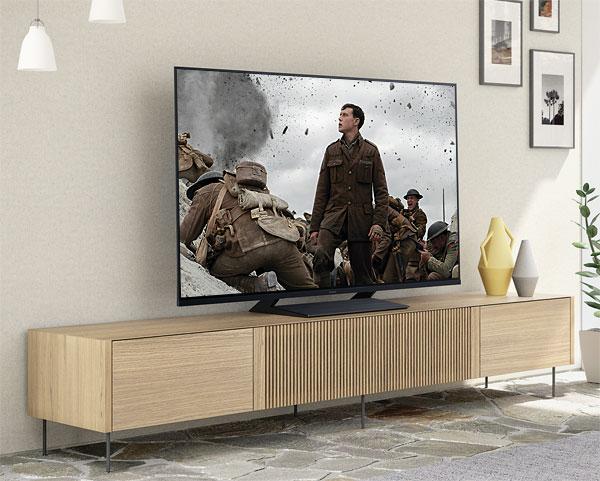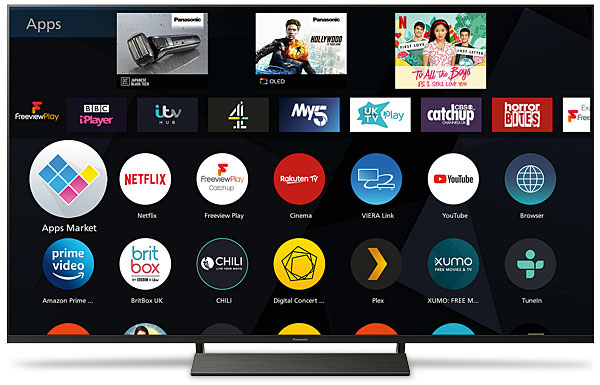Panasonic TX-58HX800 4K LED TV review

 Panasonic sets the bar high with a do-it-all mid-ranger that has a penchant for popcorn, says Steve May
Panasonic sets the bar high with a do-it-all mid-ranger that has a penchant for popcorn, says Steve May
Panasonic's multi-talented, mid-range HX800 LED LCD could be the screen home cinephiles have been clamouring for. Offering a feature specification and picture characteristics more becoming panels twice the price, it's a tempting proposition if Dolby Vision HDR and a blistering gaming performance are big on your want list.
Hot on the heels of last year's best-selling GX800 [see HCC #302 for our review of the TX-50GX800], the HX800 continues to offer universal dynamic HDR support, both Dolby Vision and HDR10+, as well as Dolby Atmos audio and an updated smart platform.
Our review sample was the £1,000 58in version, which for many will seem a manageable sweet spot in terms of size and price. The HX800 is also available in 40in (£800), 50in (£900) and 65in (£1,400) screen sizes.
This is Panasonic's entry-level multi-HDR offering, positioned below the HX900 and top-of-the-line HX940. If you consult Mr Google, you'll also find an HX820 in the wild which looks nigh on identical. This is actually a variant of the HX800 exclusive to specific retailers, without any technical differences.
The more expensive HX900 model builds on the feature specification of the HX800, but adds HDR Cinema Display, which claims to deliver increased brightness. The range-topping HX940 series adds Local Dimming Intelligent Pro, said to mimic the operation of thousands of virtual local dimming zones to improve contrast and achieve deeper blacks.
Anyway, back to the telly at hand…
Style Guru
The TX-58HX800 makes a fine first impression for a mid-tier TV. Edge-lit rather than full-array and astonishingly thin for much of its bodywork, it's afforded a genuinely minimalistic styling; interior designers will love it. I particularly like the way the panel sits on top of, rather than within, the surrounding bezel.
As with its predecessor, the screen installs on a central pedestal stand, so is easy enough to place on AV furniture.
As befits its price point, there are only three HDMI ports on offer (one of which supports ARC – but not eARC), in addition to component AV, digital optical audio output, and two USBs. The set comes with a Freeview Play tuner, but there's no satellite tuner option at all.
Dual-band Wi-Fi is standard, along with Bluetooth to support both streaming from a smartphone and headphone pairing for personal listening.
The set is supplied with a standard IR Panasonic zapper (rather than a touchpad), distinguished only by dedicated Netflix and Freeview Play buttons.

Smart functionality falls to Panasonic's My Home Screen platform, now up to its fifth iteration. The interface still consists initially of a trio of buttons, so looks a little unexciting, but is intuitive and highly customisable.
All very family-friendly, it's a doodle to add to the 'Devices', 'Apps' and 'Live TV' icons with any streaming service or connected device.
The Devices tab lists connected hardware players and networked media servers and NAS drives. If you have AV files on a Twonky or Plex media server you should have no problems playing them back.
Thanks to Panasonic's Freeview Play integration, there's a solid lineup of catch-up TV players too, alongside UKTV Play, CBS Catchup and Horror Bites. Smart home credibility comes via Google Assistant and Amazon Alexa support. There's also a decent selection of streaming services – Netflix, Amazon Prime Video, Rakuten TV, Britbox, Xumo and YouTube – although new kid on the block Disney+ is noticeable by its absence.
Colour Co-Ordinated
Last year's GX800 was a cracking-value panel, so expectations for this replacement are high – and the TX-58HX800 just about gets everything right when it comes to image quality. First and foremost, its pictures are unequivocally filmic. I'll attribute this to the involvement of Hollywood colourist Stefan Sonnenfeld, whose recent work can be seen on Bad Boys For Life and The Lion King, and who has been lending his artful eye to Panasonic's TV tuning process for a number of seasons. Unsurprisingly, the set has a tonal balance that just looks natural, even on the basic Normal image preset.
Picture modes are Dynamic, Normal, Cinema, True Cinema, Custom and Sport. All are well judged and achieve close to what you'd expect. For most programmes, I'd suggest Normal mode strikes the best balance. Predictably, Cinema is generally too dim to enthusiastically recommend for all environments. A better option when it comes to movies is True Cinema, which adds a homely punch to the picture.
The TX-58HX800 utilises the same HCX image processor seen on its predecessor, rather than the HCX Pro iteration of its costlier stablemates. It may not be blessed with the latest AI smarts but it's still able to find detail and believable nuance in any grade of source. And despite the TV's wafer thinness, screen uniformity from its edge LED system is generally good.
 |
Home Cinema Choice #351 is on sale now, featuring: Samsung S95D flagship OLED TV; Ascendo loudspeakers; Pioneer VSA-LX805 AV receiver; UST projector roundup; 2024’s summer movies; Conan 4K; and more
|

















































